Strategic Capabilities of Google: A VRIO Analysis (MM 403, Week 3)
VerifiedAdded on 2022/09/21
|9
|2144
|33
Report
AI Summary
This report delves into the concept of strategic capabilities, emphasizing how organizations leverage resources and competencies to enhance market value. The core of the analysis revolves around the VRIO framework (Value, Rarity, Imitability, and Organization), a tool for evaluating internal resources and capabilities to achieve a competitive edge. The report uses Google as a real-world example, applying the VRIO framework to assess its strategic strengths, including its human resource capital and data utilization. The analysis covers each element of the VRIO framework, explaining how Google's resources meet the criteria for sustained competitive advantage. The report also touches upon the importance of continuous adaptation in strategic activities, highlighting the necessity for companies to evolve their strategies to maintain a competitive edge. Additionally, the report includes an introduction to strategic capabilities, models and frameworks like RBV, Diamond model and VRIO framework, and a conclusion that reiterates the significance of strategic analysis techniques and their impact on job creation, cost reduction, and customer value.
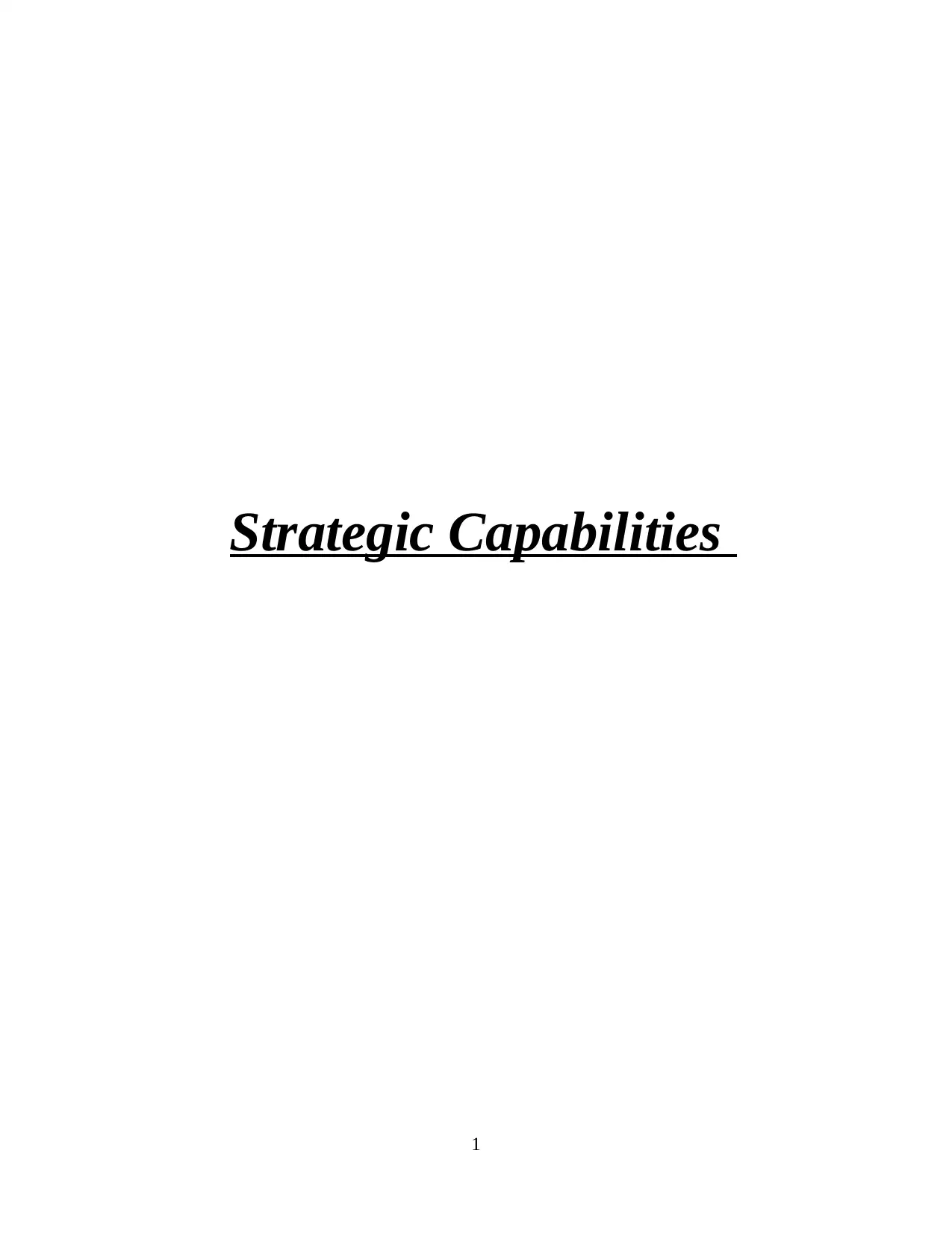
Strategic Capabilities
1
1
Paraphrase This Document
Need a fresh take? Get an instant paraphrase of this document with our AI Paraphraser
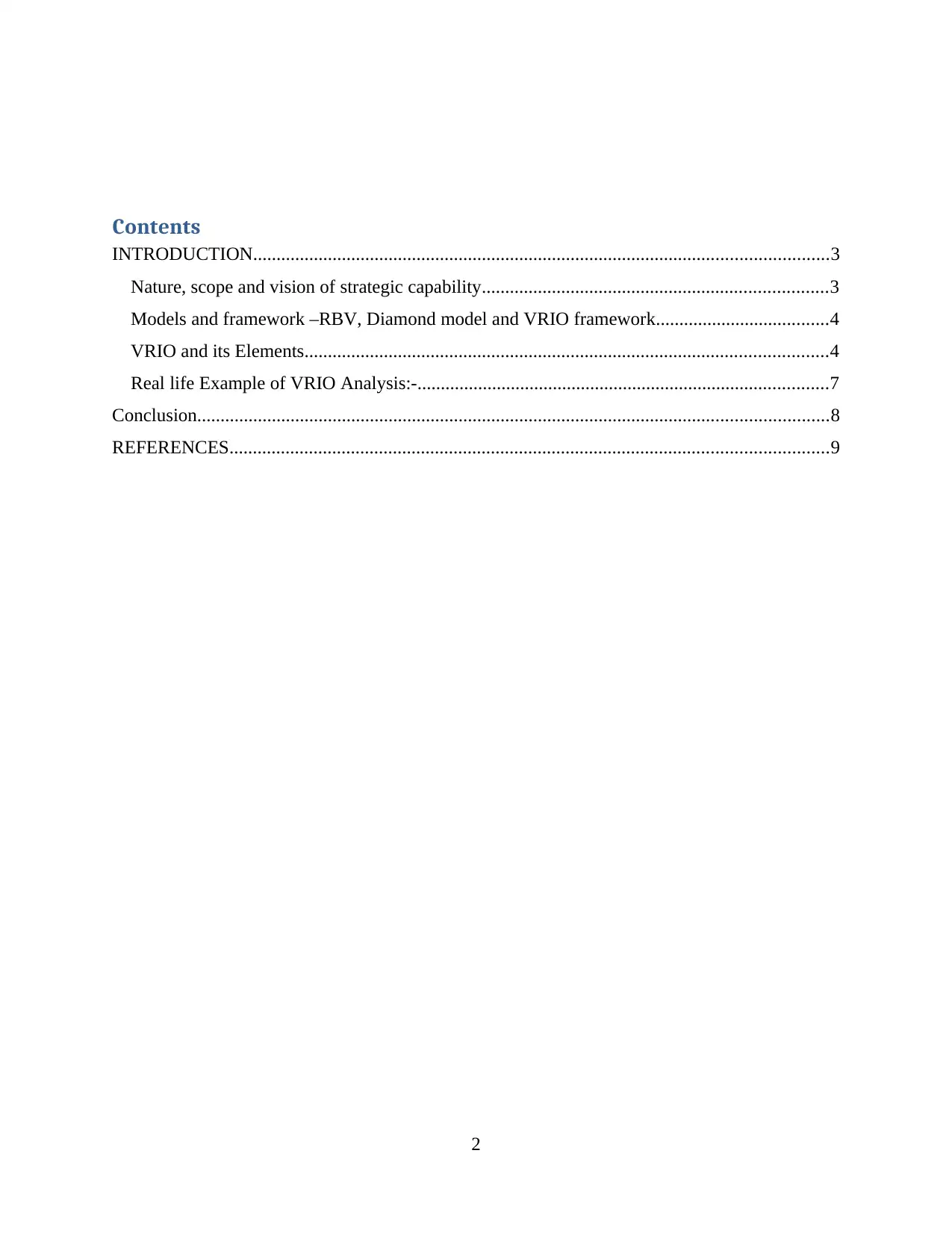
Contents
INTRODUCTION...........................................................................................................................3
Nature, scope and vision of strategic capability..........................................................................3
Models and framework –RBV, Diamond model and VRIO framework.....................................4
VRIO and its Elements................................................................................................................4
Real life Example of VRIO Analysis:-........................................................................................7
Conclusion.......................................................................................................................................8
REFERENCES................................................................................................................................9
2
INTRODUCTION...........................................................................................................................3
Nature, scope and vision of strategic capability..........................................................................3
Models and framework –RBV, Diamond model and VRIO framework.....................................4
VRIO and its Elements................................................................................................................4
Real life Example of VRIO Analysis:-........................................................................................7
Conclusion.......................................................................................................................................8
REFERENCES................................................................................................................................9
2
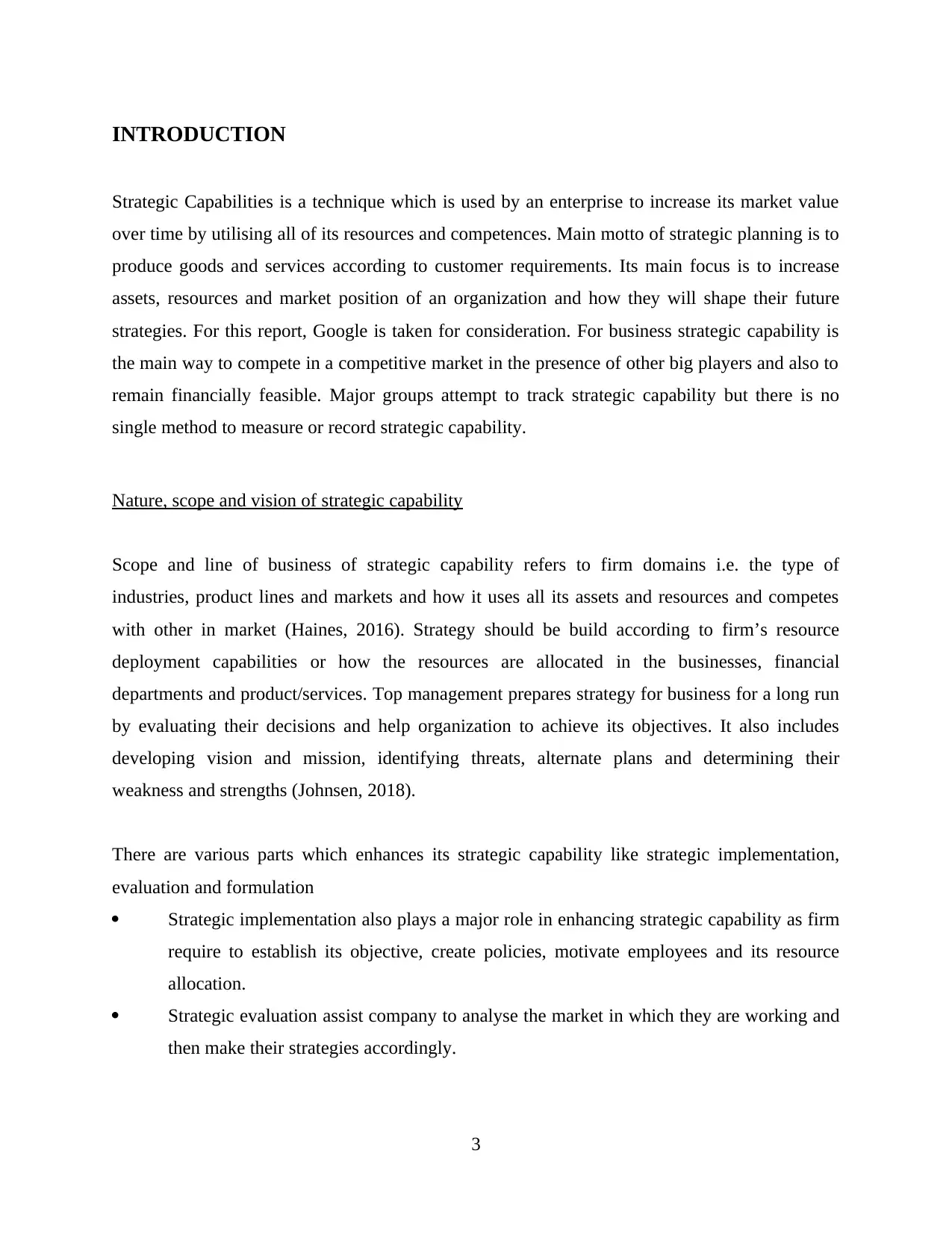
INTRODUCTION
Strategic Capabilities is a technique which is used by an enterprise to increase its market value
over time by utilising all of its resources and competences. Main motto of strategic planning is to
produce goods and services according to customer requirements. Its main focus is to increase
assets, resources and market position of an organization and how they will shape their future
strategies. For this report, Google is taken for consideration. For business strategic capability is
the main way to compete in a competitive market in the presence of other big players and also to
remain financially feasible. Major groups attempt to track strategic capability but there is no
single method to measure or record strategic capability.
Nature, scope and vision of strategic capability
Scope and line of business of strategic capability refers to firm domains i.e. the type of
industries, product lines and markets and how it uses all its assets and resources and competes
with other in market (Haines, 2016). Strategy should be build according to firm’s resource
deployment capabilities or how the resources are allocated in the businesses, financial
departments and product/services. Top management prepares strategy for business for a long run
by evaluating their decisions and help organization to achieve its objectives. It also includes
developing vision and mission, identifying threats, alternate plans and determining their
weakness and strengths (Johnsen, 2018).
There are various parts which enhances its strategic capability like strategic implementation,
evaluation and formulation
Strategic implementation also plays a major role in enhancing strategic capability as firm
require to establish its objective, create policies, motivate employees and its resource
allocation.
Strategic evaluation assist company to analyse the market in which they are working and
then make their strategies accordingly.
3
Strategic Capabilities is a technique which is used by an enterprise to increase its market value
over time by utilising all of its resources and competences. Main motto of strategic planning is to
produce goods and services according to customer requirements. Its main focus is to increase
assets, resources and market position of an organization and how they will shape their future
strategies. For this report, Google is taken for consideration. For business strategic capability is
the main way to compete in a competitive market in the presence of other big players and also to
remain financially feasible. Major groups attempt to track strategic capability but there is no
single method to measure or record strategic capability.
Nature, scope and vision of strategic capability
Scope and line of business of strategic capability refers to firm domains i.e. the type of
industries, product lines and markets and how it uses all its assets and resources and competes
with other in market (Haines, 2016). Strategy should be build according to firm’s resource
deployment capabilities or how the resources are allocated in the businesses, financial
departments and product/services. Top management prepares strategy for business for a long run
by evaluating their decisions and help organization to achieve its objectives. It also includes
developing vision and mission, identifying threats, alternate plans and determining their
weakness and strengths (Johnsen, 2018).
There are various parts which enhances its strategic capability like strategic implementation,
evaluation and formulation
Strategic implementation also plays a major role in enhancing strategic capability as firm
require to establish its objective, create policies, motivate employees and its resource
allocation.
Strategic evaluation assist company to analyse the market in which they are working and
then make their strategies accordingly.
3
⊘ This is a preview!⊘
Do you want full access?
Subscribe today to unlock all pages.

Trusted by 1+ million students worldwide
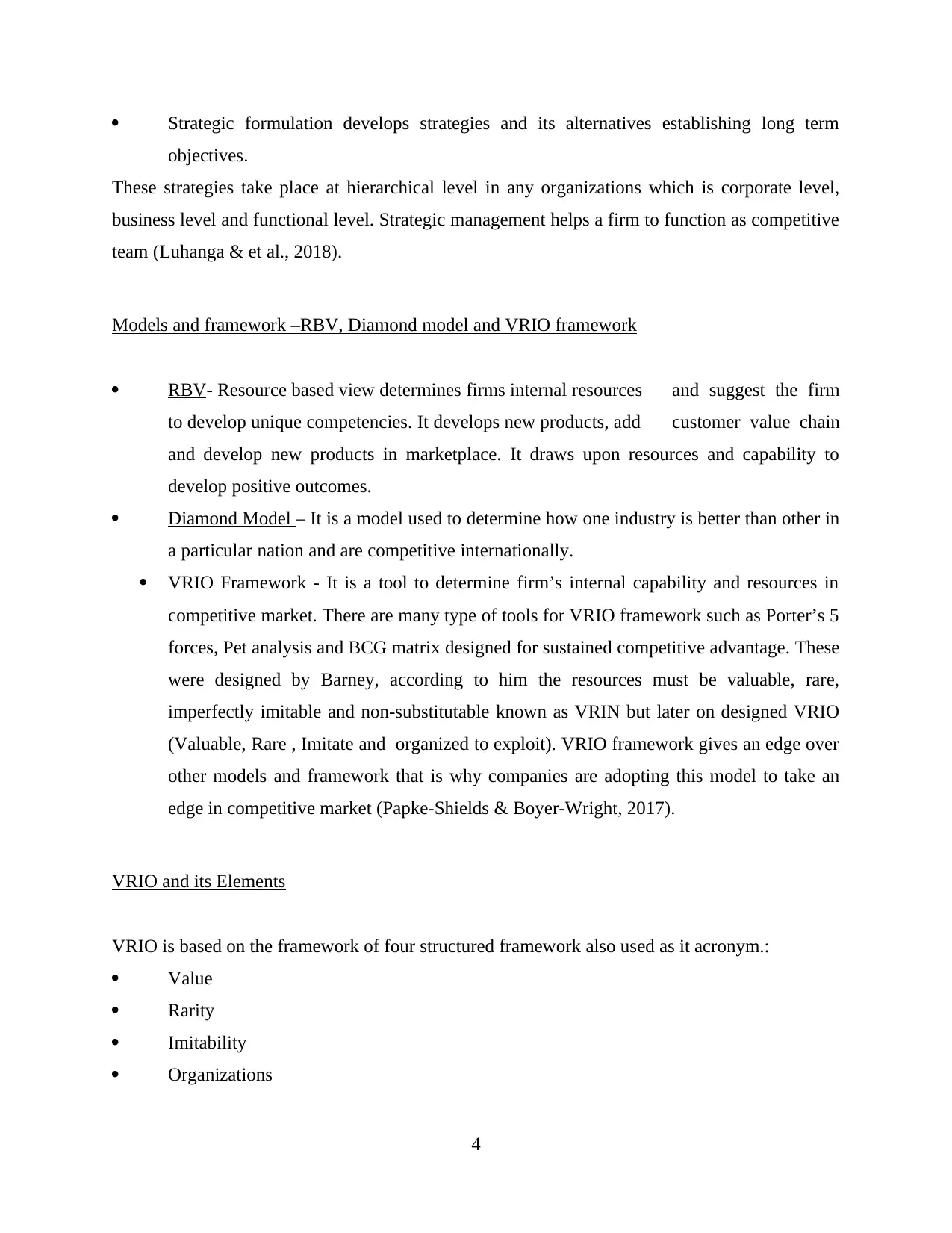
Strategic formulation develops strategies and its alternatives establishing long term
objectives.
These strategies take place at hierarchical level in any organizations which is corporate level,
business level and functional level. Strategic management helps a firm to function as competitive
team (Luhanga & et al., 2018).
Models and framework –RBV, Diamond model and VRIO framework
RBV- Resource based view determines firms internal resources and suggest the firm
to develop unique competencies. It develops new products, add customer value chain
and develop new products in marketplace. It draws upon resources and capability to
develop positive outcomes.
Diamond Model – It is a model used to determine how one industry is better than other in
a particular nation and are competitive internationally.
VRIO Framework - It is a tool to determine firm’s internal capability and resources in
competitive market. There are many type of tools for VRIO framework such as Porter’s 5
forces, Pet analysis and BCG matrix designed for sustained competitive advantage. These
were designed by Barney, according to him the resources must be valuable, rare,
imperfectly imitable and non-substitutable known as VRIN but later on designed VRIO
(Valuable, Rare , Imitate and organized to exploit). VRIO framework gives an edge over
other models and framework that is why companies are adopting this model to take an
edge in competitive market (Papke-Shields & Boyer-Wright, 2017).
VRIO and its Elements
VRIO is based on the framework of four structured framework also used as it acronym.:
Value
Rarity
Imitability
Organizations
4
objectives.
These strategies take place at hierarchical level in any organizations which is corporate level,
business level and functional level. Strategic management helps a firm to function as competitive
team (Luhanga & et al., 2018).
Models and framework –RBV, Diamond model and VRIO framework
RBV- Resource based view determines firms internal resources and suggest the firm
to develop unique competencies. It develops new products, add customer value chain
and develop new products in marketplace. It draws upon resources and capability to
develop positive outcomes.
Diamond Model – It is a model used to determine how one industry is better than other in
a particular nation and are competitive internationally.
VRIO Framework - It is a tool to determine firm’s internal capability and resources in
competitive market. There are many type of tools for VRIO framework such as Porter’s 5
forces, Pet analysis and BCG matrix designed for sustained competitive advantage. These
were designed by Barney, according to him the resources must be valuable, rare,
imperfectly imitable and non-substitutable known as VRIN but later on designed VRIO
(Valuable, Rare , Imitate and organized to exploit). VRIO framework gives an edge over
other models and framework that is why companies are adopting this model to take an
edge in competitive market (Papke-Shields & Boyer-Wright, 2017).
VRIO and its Elements
VRIO is based on the framework of four structured framework also used as it acronym.:
Value
Rarity
Imitability
Organizations
4
Paraphrase This Document
Need a fresh take? Get an instant paraphrase of this document with our AI Paraphraser
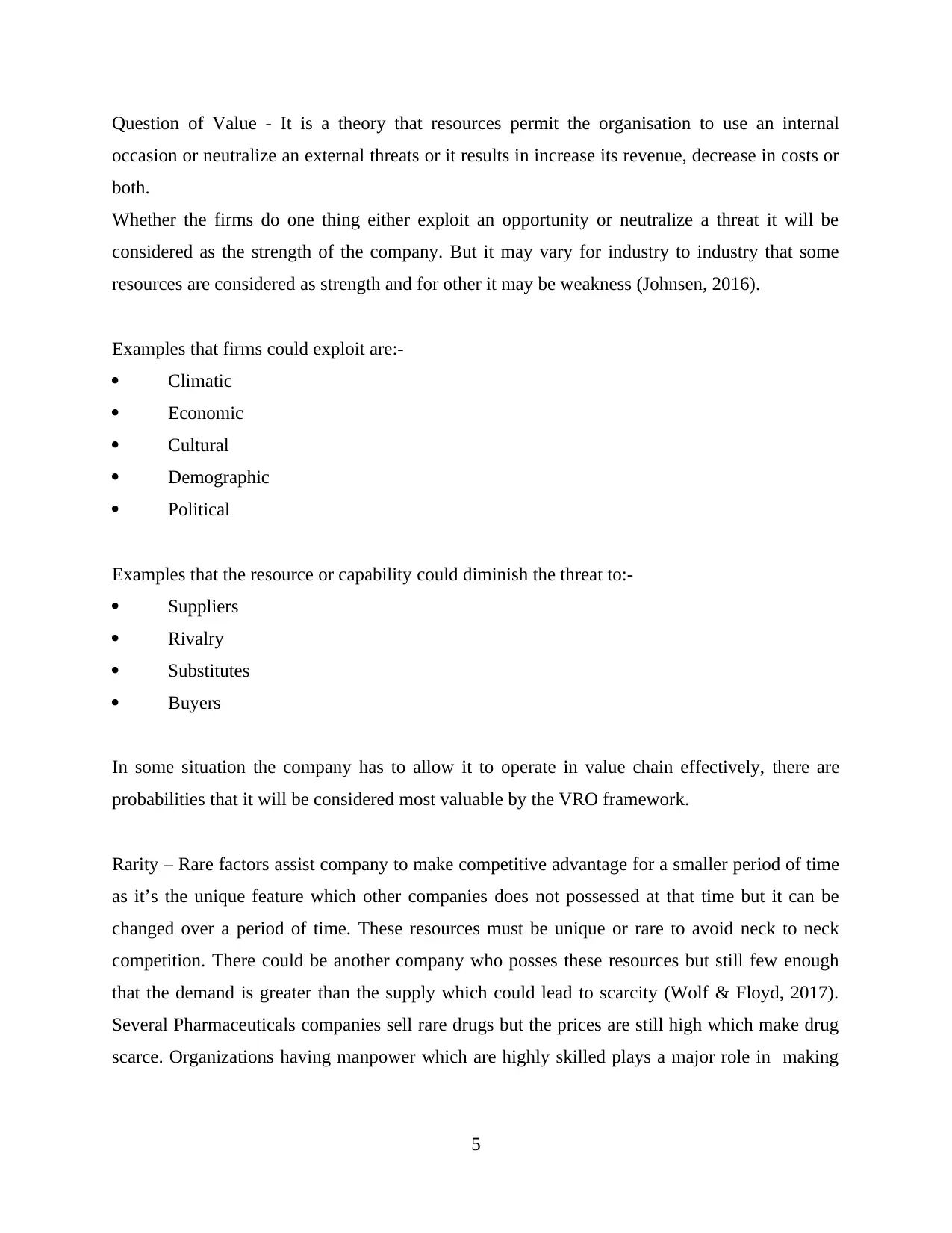
Question of Value - It is a theory that resources permit the organisation to use an internal
occasion or neutralize an external threats or it results in increase its revenue, decrease in costs or
both.
Whether the firms do one thing either exploit an opportunity or neutralize a threat it will be
considered as the strength of the company. But it may vary for industry to industry that some
resources are considered as strength and for other it may be weakness (Johnsen, 2016).
Examples that firms could exploit are:-
Climatic
Economic
Cultural
Demographic
Political
Examples that the resource or capability could diminish the threat to:-
Suppliers
Rivalry
Substitutes
Buyers
In some situation the company has to allow it to operate in value chain effectively, there are
probabilities that it will be considered most valuable by the VRO framework.
Rarity – Rare factors assist company to make competitive advantage for a smaller period of time
as it’s the unique feature which other companies does not possessed at that time but it can be
changed over a period of time. These resources must be unique or rare to avoid neck to neck
competition. There could be another company who posses these resources but still few enough
that the demand is greater than the supply which could lead to scarcity (Wolf & Floyd, 2017).
Several Pharmaceuticals companies sell rare drugs but the prices are still high which make drug
scarce. Organizations having manpower which are highly skilled plays a major role in making
5
occasion or neutralize an external threats or it results in increase its revenue, decrease in costs or
both.
Whether the firms do one thing either exploit an opportunity or neutralize a threat it will be
considered as the strength of the company. But it may vary for industry to industry that some
resources are considered as strength and for other it may be weakness (Johnsen, 2016).
Examples that firms could exploit are:-
Climatic
Economic
Cultural
Demographic
Political
Examples that the resource or capability could diminish the threat to:-
Suppliers
Rivalry
Substitutes
Buyers
In some situation the company has to allow it to operate in value chain effectively, there are
probabilities that it will be considered most valuable by the VRO framework.
Rarity – Rare factors assist company to make competitive advantage for a smaller period of time
as it’s the unique feature which other companies does not possessed at that time but it can be
changed over a period of time. These resources must be unique or rare to avoid neck to neck
competition. There could be another company who posses these resources but still few enough
that the demand is greater than the supply which could lead to scarcity (Wolf & Floyd, 2017).
Several Pharmaceuticals companies sell rare drugs but the prices are still high which make drug
scarce. Organizations having manpower which are highly skilled plays a major role in making
5
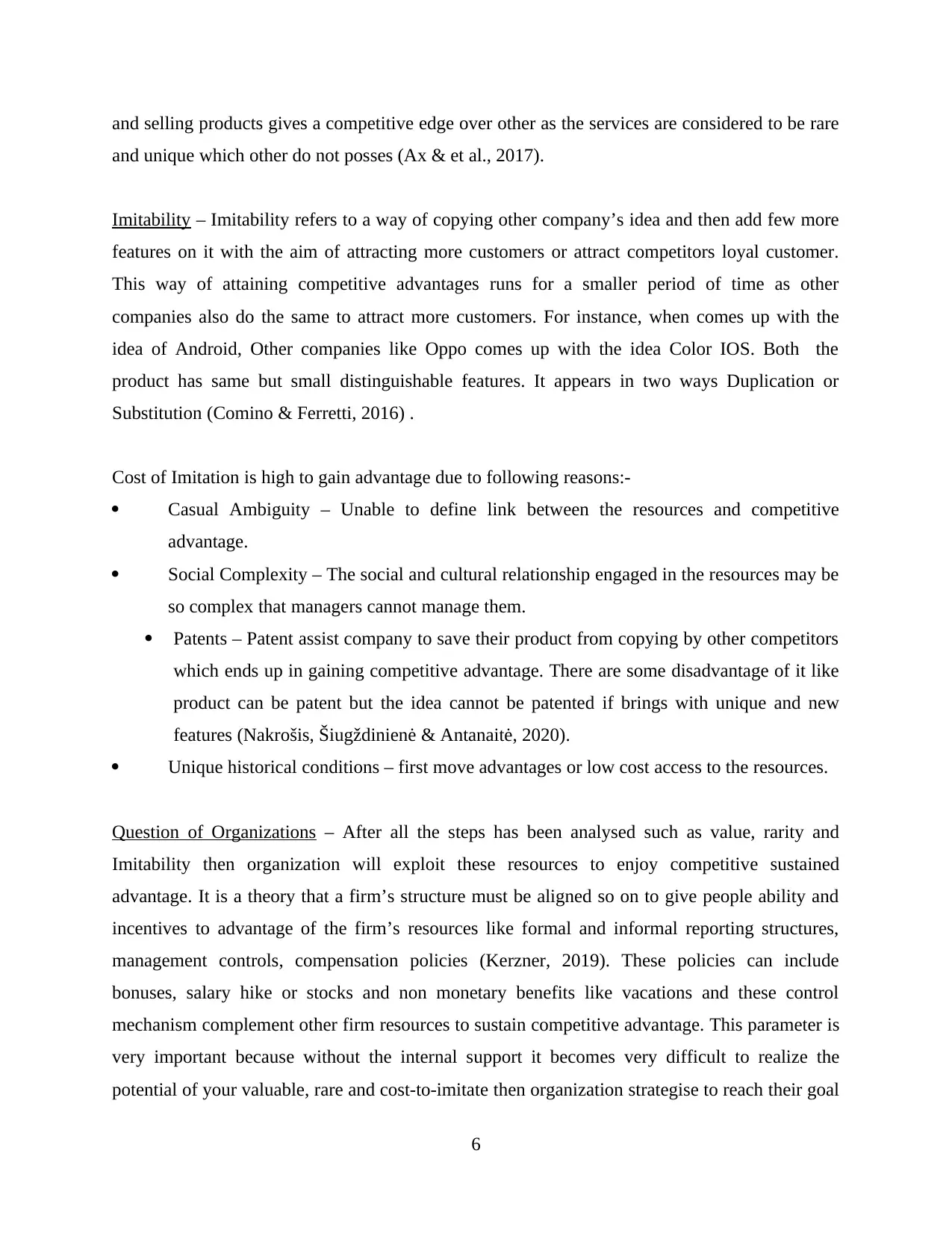
and selling products gives a competitive edge over other as the services are considered to be rare
and unique which other do not posses (Ax & et al., 2017).
Imitability – Imitability refers to a way of copying other company’s idea and then add few more
features on it with the aim of attracting more customers or attract competitors loyal customer.
This way of attaining competitive advantages runs for a smaller period of time as other
companies also do the same to attract more customers. For instance, when comes up with the
idea of Android, Other companies like Oppo comes up with the idea Color IOS. Both the
product has same but small distinguishable features. It appears in two ways Duplication or
Substitution (Comino & Ferretti, 2016) .
Cost of Imitation is high to gain advantage due to following reasons:-
Casual Ambiguity – Unable to define link between the resources and competitive
advantage.
Social Complexity – The social and cultural relationship engaged in the resources may be
so complex that managers cannot manage them.
Patents – Patent assist company to save their product from copying by other competitors
which ends up in gaining competitive advantage. There are some disadvantage of it like
product can be patent but the idea cannot be patented if brings with unique and new
features (Nakrošis, Šiugždinienė & Antanaitė, 2020).
Unique historical conditions – first move advantages or low cost access to the resources.
Question of Organizations – After all the steps has been analysed such as value, rarity and
Imitability then organization will exploit these resources to enjoy competitive sustained
advantage. It is a theory that a firm’s structure must be aligned so on to give people ability and
incentives to advantage of the firm’s resources like formal and informal reporting structures,
management controls, compensation policies (Kerzner, 2019). These policies can include
bonuses, salary hike or stocks and non monetary benefits like vacations and these control
mechanism complement other firm resources to sustain competitive advantage. This parameter is
very important because without the internal support it becomes very difficult to realize the
potential of your valuable, rare and cost-to-imitate then organization strategise to reach their goal
6
and unique which other do not posses (Ax & et al., 2017).
Imitability – Imitability refers to a way of copying other company’s idea and then add few more
features on it with the aim of attracting more customers or attract competitors loyal customer.
This way of attaining competitive advantages runs for a smaller period of time as other
companies also do the same to attract more customers. For instance, when comes up with the
idea of Android, Other companies like Oppo comes up with the idea Color IOS. Both the
product has same but small distinguishable features. It appears in two ways Duplication or
Substitution (Comino & Ferretti, 2016) .
Cost of Imitation is high to gain advantage due to following reasons:-
Casual Ambiguity – Unable to define link between the resources and competitive
advantage.
Social Complexity – The social and cultural relationship engaged in the resources may be
so complex that managers cannot manage them.
Patents – Patent assist company to save their product from copying by other competitors
which ends up in gaining competitive advantage. There are some disadvantage of it like
product can be patent but the idea cannot be patented if brings with unique and new
features (Nakrošis, Šiugždinienė & Antanaitė, 2020).
Unique historical conditions – first move advantages or low cost access to the resources.
Question of Organizations – After all the steps has been analysed such as value, rarity and
Imitability then organization will exploit these resources to enjoy competitive sustained
advantage. It is a theory that a firm’s structure must be aligned so on to give people ability and
incentives to advantage of the firm’s resources like formal and informal reporting structures,
management controls, compensation policies (Kerzner, 2019). These policies can include
bonuses, salary hike or stocks and non monetary benefits like vacations and these control
mechanism complement other firm resources to sustain competitive advantage. This parameter is
very important because without the internal support it becomes very difficult to realize the
potential of your valuable, rare and cost-to-imitate then organization strategise to reach their goal
6
⊘ This is a preview!⊘
Do you want full access?
Subscribe today to unlock all pages.

Trusted by 1+ million students worldwide
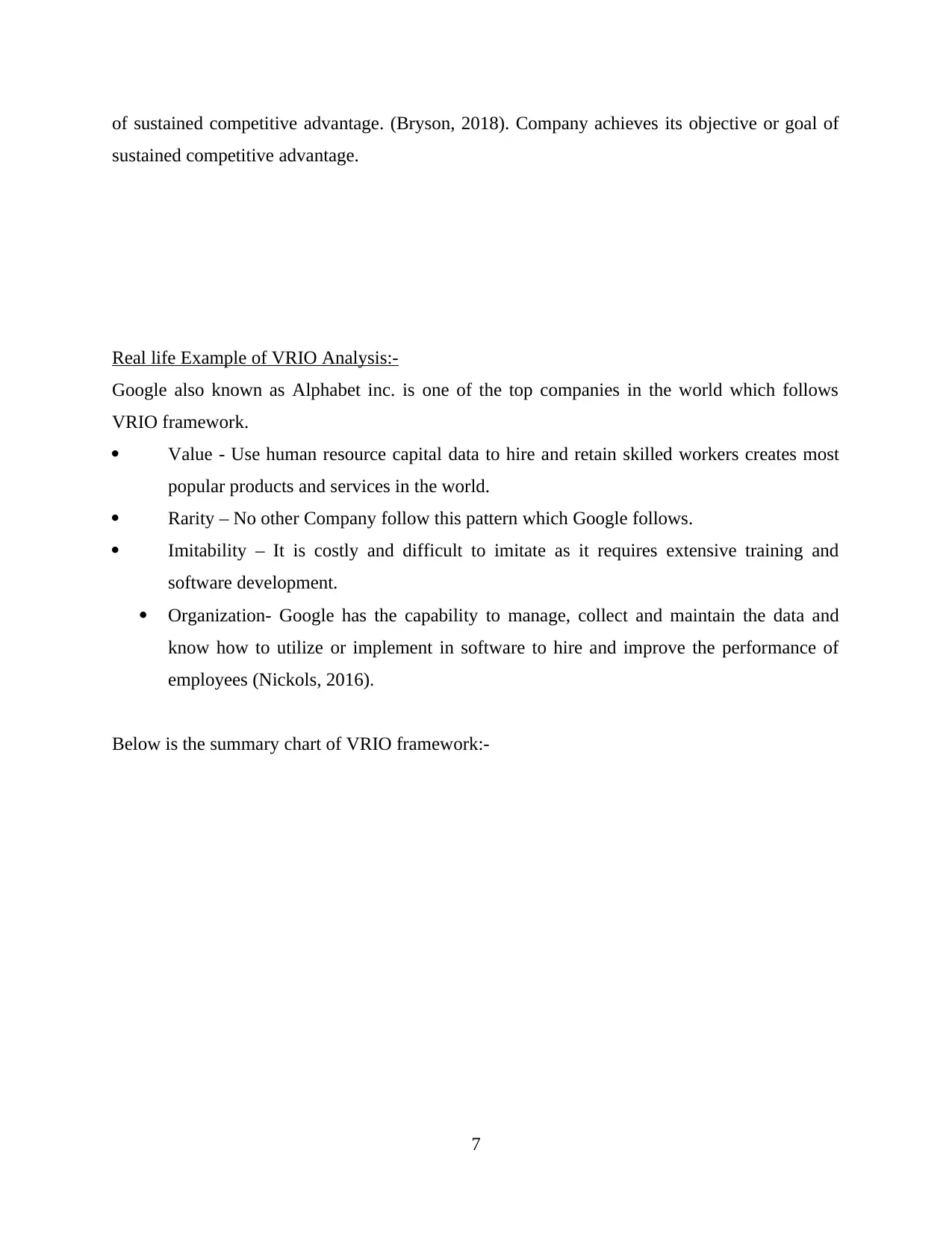
of sustained competitive advantage. (Bryson, 2018). Company achieves its objective or goal of
sustained competitive advantage.
Real life Example of VRIO Analysis:-
Google also known as Alphabet inc. is one of the top companies in the world which follows
VRIO framework.
Value - Use human resource capital data to hire and retain skilled workers creates most
popular products and services in the world.
Rarity – No other Company follow this pattern which Google follows.
Imitability – It is costly and difficult to imitate as it requires extensive training and
software development.
Organization- Google has the capability to manage, collect and maintain the data and
know how to utilize or implement in software to hire and improve the performance of
employees (Nickols, 2016).
Below is the summary chart of VRIO framework:-
7
sustained competitive advantage.
Real life Example of VRIO Analysis:-
Google also known as Alphabet inc. is one of the top companies in the world which follows
VRIO framework.
Value - Use human resource capital data to hire and retain skilled workers creates most
popular products and services in the world.
Rarity – No other Company follow this pattern which Google follows.
Imitability – It is costly and difficult to imitate as it requires extensive training and
software development.
Organization- Google has the capability to manage, collect and maintain the data and
know how to utilize or implement in software to hire and improve the performance of
employees (Nickols, 2016).
Below is the summary chart of VRIO framework:-
7
Paraphrase This Document
Need a fresh take? Get an instant paraphrase of this document with our AI Paraphraser
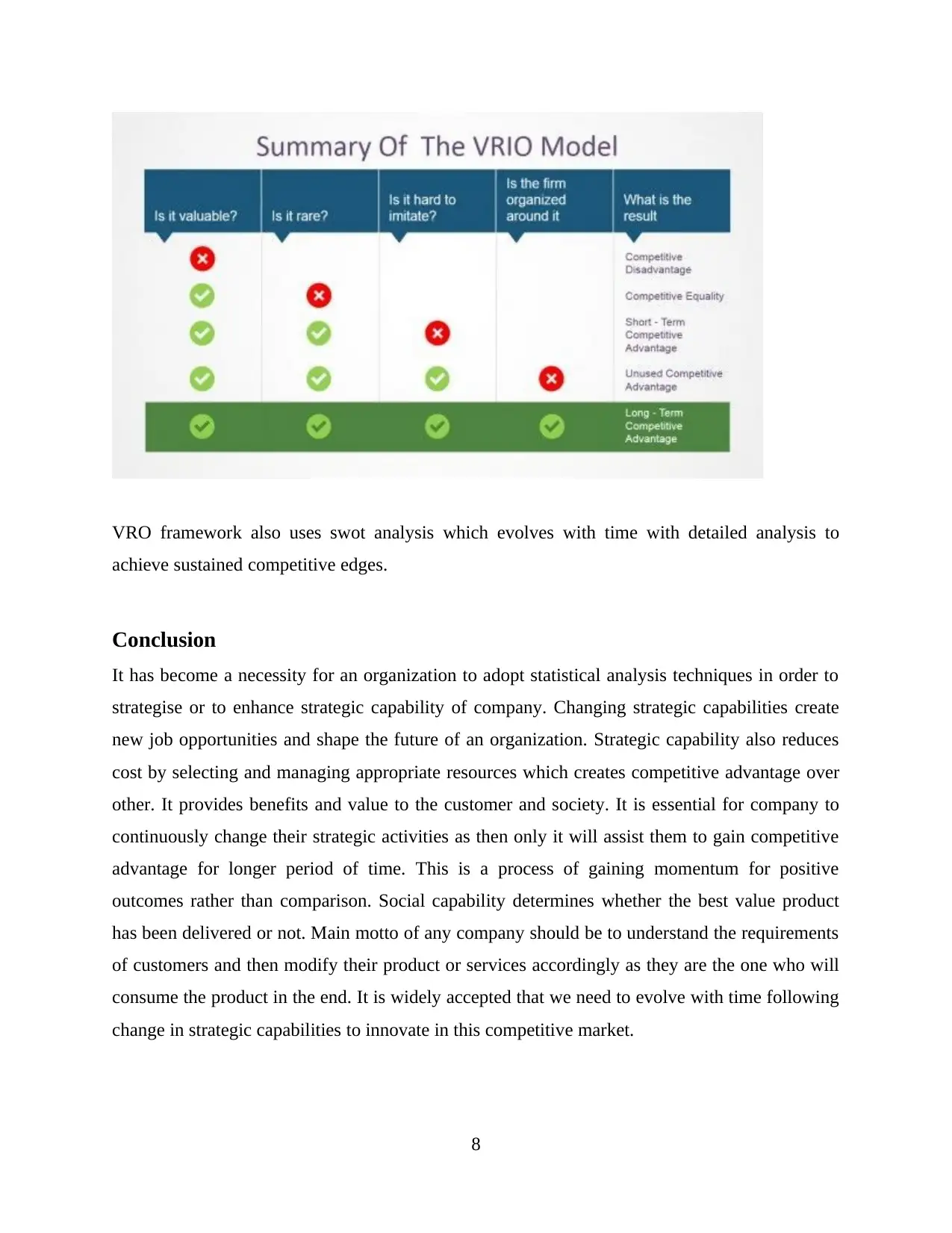
VRO framework also uses swot analysis which evolves with time with detailed analysis to
achieve sustained competitive edges.
Conclusion
It has become a necessity for an organization to adopt statistical analysis techniques in order to
strategise or to enhance strategic capability of company. Changing strategic capabilities create
new job opportunities and shape the future of an organization. Strategic capability also reduces
cost by selecting and managing appropriate resources which creates competitive advantage over
other. It provides benefits and value to the customer and society. It is essential for company to
continuously change their strategic activities as then only it will assist them to gain competitive
advantage for longer period of time. This is a process of gaining momentum for positive
outcomes rather than comparison. Social capability determines whether the best value product
has been delivered or not. Main motto of any company should be to understand the requirements
of customers and then modify their product or services accordingly as they are the one who will
consume the product in the end. It is widely accepted that we need to evolve with time following
change in strategic capabilities to innovate in this competitive market.
8
achieve sustained competitive edges.
Conclusion
It has become a necessity for an organization to adopt statistical analysis techniques in order to
strategise or to enhance strategic capability of company. Changing strategic capabilities create
new job opportunities and shape the future of an organization. Strategic capability also reduces
cost by selecting and managing appropriate resources which creates competitive advantage over
other. It provides benefits and value to the customer and society. It is essential for company to
continuously change their strategic activities as then only it will assist them to gain competitive
advantage for longer period of time. This is a process of gaining momentum for positive
outcomes rather than comparison. Social capability determines whether the best value product
has been delivered or not. Main motto of any company should be to understand the requirements
of customers and then modify their product or services accordingly as they are the one who will
consume the product in the end. It is widely accepted that we need to evolve with time following
change in strategic capabilities to innovate in this competitive market.
8
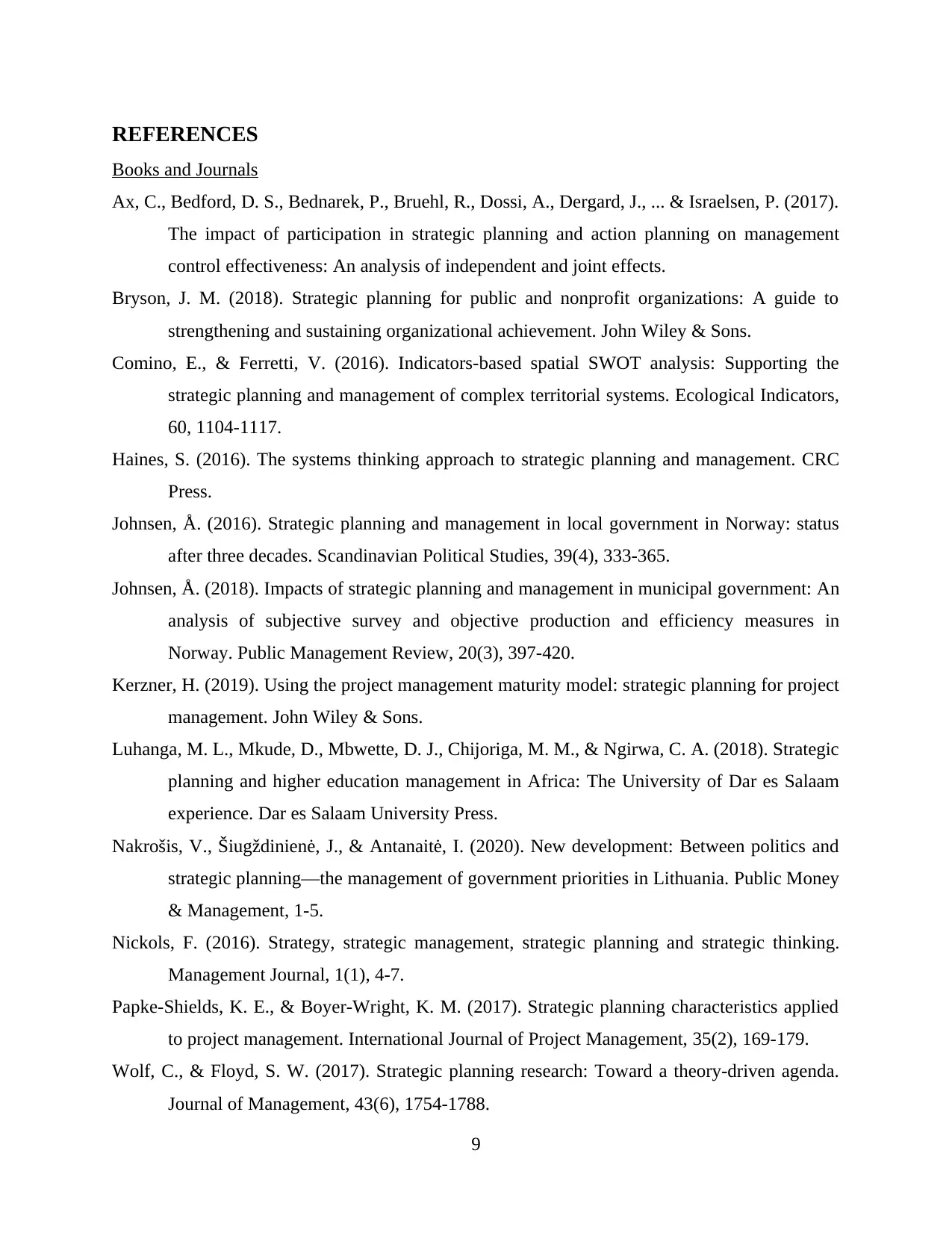
REFERENCES
Books and Journals
Ax, C., Bedford, D. S., Bednarek, P., Bruehl, R., Dossi, A., Dergard, J., ... & Israelsen, P. (2017).
The impact of participation in strategic planning and action planning on management
control effectiveness: An analysis of independent and joint effects.
Bryson, J. M. (2018). Strategic planning for public and nonprofit organizations: A guide to
strengthening and sustaining organizational achievement. John Wiley & Sons.
Comino, E., & Ferretti, V. (2016). Indicators-based spatial SWOT analysis: Supporting the
strategic planning and management of complex territorial systems. Ecological Indicators,
60, 1104-1117.
Haines, S. (2016). The systems thinking approach to strategic planning and management. CRC
Press.
Johnsen, Å. (2016). Strategic planning and management in local government in Norway: status
after three decades. Scandinavian Political Studies, 39(4), 333-365.
Johnsen, Å. (2018). Impacts of strategic planning and management in municipal government: An
analysis of subjective survey and objective production and efficiency measures in
Norway. Public Management Review, 20(3), 397-420.
Kerzner, H. (2019). Using the project management maturity model: strategic planning for project
management. John Wiley & Sons.
Luhanga, M. L., Mkude, D., Mbwette, D. J., Chijoriga, M. M., & Ngirwa, C. A. (2018). Strategic
planning and higher education management in Africa: The University of Dar es Salaam
experience. Dar es Salaam University Press.
Nakrošis, V., Šiugždinienė, J., & Antanaitė, I. (2020). New development: Between politics and
strategic planning—the management of government priorities in Lithuania. Public Money
& Management, 1-5.
Nickols, F. (2016). Strategy, strategic management, strategic planning and strategic thinking.
Management Journal, 1(1), 4-7.
Papke-Shields, K. E., & Boyer-Wright, K. M. (2017). Strategic planning characteristics applied
to project management. International Journal of Project Management, 35(2), 169-179.
Wolf, C., & Floyd, S. W. (2017). Strategic planning research: Toward a theory-driven agenda.
Journal of Management, 43(6), 1754-1788.
9
Books and Journals
Ax, C., Bedford, D. S., Bednarek, P., Bruehl, R., Dossi, A., Dergard, J., ... & Israelsen, P. (2017).
The impact of participation in strategic planning and action planning on management
control effectiveness: An analysis of independent and joint effects.
Bryson, J. M. (2018). Strategic planning for public and nonprofit organizations: A guide to
strengthening and sustaining organizational achievement. John Wiley & Sons.
Comino, E., & Ferretti, V. (2016). Indicators-based spatial SWOT analysis: Supporting the
strategic planning and management of complex territorial systems. Ecological Indicators,
60, 1104-1117.
Haines, S. (2016). The systems thinking approach to strategic planning and management. CRC
Press.
Johnsen, Å. (2016). Strategic planning and management in local government in Norway: status
after three decades. Scandinavian Political Studies, 39(4), 333-365.
Johnsen, Å. (2018). Impacts of strategic planning and management in municipal government: An
analysis of subjective survey and objective production and efficiency measures in
Norway. Public Management Review, 20(3), 397-420.
Kerzner, H. (2019). Using the project management maturity model: strategic planning for project
management. John Wiley & Sons.
Luhanga, M. L., Mkude, D., Mbwette, D. J., Chijoriga, M. M., & Ngirwa, C. A. (2018). Strategic
planning and higher education management in Africa: The University of Dar es Salaam
experience. Dar es Salaam University Press.
Nakrošis, V., Šiugždinienė, J., & Antanaitė, I. (2020). New development: Between politics and
strategic planning—the management of government priorities in Lithuania. Public Money
& Management, 1-5.
Nickols, F. (2016). Strategy, strategic management, strategic planning and strategic thinking.
Management Journal, 1(1), 4-7.
Papke-Shields, K. E., & Boyer-Wright, K. M. (2017). Strategic planning characteristics applied
to project management. International Journal of Project Management, 35(2), 169-179.
Wolf, C., & Floyd, S. W. (2017). Strategic planning research: Toward a theory-driven agenda.
Journal of Management, 43(6), 1754-1788.
9
⊘ This is a preview!⊘
Do you want full access?
Subscribe today to unlock all pages.

Trusted by 1+ million students worldwide
1 out of 9
Related Documents
Your All-in-One AI-Powered Toolkit for Academic Success.
+13062052269
info@desklib.com
Available 24*7 on WhatsApp / Email
![[object Object]](/_next/static/media/star-bottom.7253800d.svg)
Unlock your academic potential
Copyright © 2020–2025 A2Z Services. All Rights Reserved. Developed and managed by ZUCOL.




